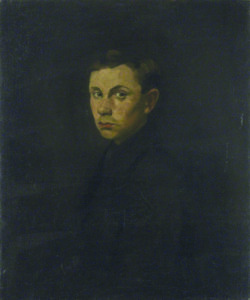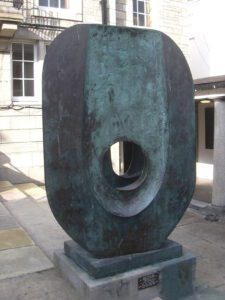
DN: I want to talk about the decline of St Ives in the art world but I suppose first we should talk about how it came to be a flowering of artists to begin with.
TC: What flowering are we talking about, there were several? They come in waves in St Ives.
DN: I suppose I am referring to the post Second World War period.

Louise, Breton Girl
TC: Which is mine and Derek Guthrie’s time, of course, the St Ives ‘Modern School’ period, but I don’t think you can look at St Ives then without looking at its longer history. Cornwall saw Artists’ Colonies founded here from the mid-1800s part of a major, but very poorly documented, international movement in art. With the arrival of the railway, Newlyn and St Ives had became very important from the 1880s. There’s your first flowering.
DN: How did this come about?
TC: Post the Industrial Revolution art practice had become city oriented and studio based. Artists decided to get out and seek ‘an academy of nature’ and paint in the open ‘en plein air’. They may have been inspired by the example of earlier painters like JMW Turner, who incidentally had visited St Ives.
DN: And this ‘movement’ was international?
TC: Yes. It links us to artists’ colonies like: Woodstock, Yaddo and Provincetown in the States; Concarneau, Pont Aven and Barbizon in France and Scandinavian and German colonies like Skagen and Worpswede respectively. An artist might spend several years in several colonies. Major ‘St Ives’ artists during this flowering were people like Helene Schjerfbeck and Anders Zorn, Scandinavians: as well as Americans and the Brits.
DN: Coming from cities did these artists have a romantic view of what nature is actually like?
TC: In the 1960s this was a prevalent view of Newlyn School painting. What these painters found, though, was that life in Cornwall was hard, as was rural life elsewhere. Fisherman drowned, boats sank and miners died underground, wives were widowed and children orphaned. Frank Bramley’s Hopeless Dawn and WHY Titcomb’s Primitive Methodists are more a sort of Victorian social realism than romantic paintings but, of course nature can be idyllic too.
DN: Were these new arrivals welcome in St Ives.
TC: The Cornish have always been adaptable and welcoming. Local people modelled for the artists who became respected for their skill of ‘head and hand’. A tradition of ‘open studio’ show days started so artists could let the local people see their work and this fostered a mutual respect. Persuaded by Whistler, James Lanham stocked artist’s materials, opened studios and began picture framing for pictures transported to London for Royal Academy exhibitions.
DN: A regular cottage industry.
TC: Hardly ‘cottage’ when you think that later on St Ives firms transported Hepworth’s sculptures to exhibitions around the world. It was one of the things about Hepworth that she always used local tradesmen and that was appreciated.
DN: So the 19th century history of St Ives made it the obvious choice for Ben Nicholson and Barbara Hepworth?
TC: In that it paved the way for a ‘second flowing’ between the wars, perhaps. The St Ives Society of Artists (founded in 1927) and its Secretary Captain Borlase Smart re-established St Ives international reputation between the wars. Ben Nicholson, Barbara Hepworth and their triplets came to St Ives in 1939, ahead of the London blitz. They had friends here and were welcomed into the Society, despite the reservations of the traditional painters. Nicholson knew Cornwall well and had been down in St Ives in 1928 when with Kit Wood he ‘discovered’ the primitive local painter Alfred Wallis.

DN: I read somewhere in one of your articles that they read and admired D H Lawrence
TC: Lawrence is part of the history of artists and writers coming to live in Cornwall. I have a copy of a letter the military sent to Lawrence ordering him out of the County. Patrick Heron and Karl Weschke were minds of information on Lawrence, certainly.
DN: So the history and the creative energy was already here?
TC: Very much so and not just for painting. A Commando training unit was based in St Ives during the war evolving techniques for covert coastal and cliff assault. It was very creative stuff and dangerous. They designed all sorts of kit, knocked up by a local blacksmith including the ‘gripfast’, a ‘death-slide’ [zip-wire] rigging anchor that works on sand and is still in use today. Night landings practised in the dark on St Ives beaches would leave a few soldiers suffering from hypothermia and they were taken into the Gas Works, which stood where Tate St Ives is now, to warm up. If Tate ever leaves St Ives the building would make a fine military museum. This town is rich in history.
DN: So this was going on around the artists here in the war. And how did their flowering happen?
TC: Nicholson was excellent at promotion. He gave ‘marketing’ a lot of attention. Art was his profession and believed the artist should be professional in his approach. Many artists don’t understand this, they just want to paint and they really don’t know how to sell their work. Ben & Barbara founded the Penwith Society of Arts, breaking away from the St Ives Society in 1949. The Penwith was the marketing vehicle for the St Ives Modern movement. They were also active in the community. Nicholson won the first Guggenheim International painting prize in 1956 and used this new found celebrity to try and persuade the council to build self-contained studio-flats for artists.
DN: Really? Who would have been in charge of them?
TC: Sadly, it never got that far. The council told him it was a nice idea but they would have to build their quota of council houses before his idea could be considered.
DN: So how did he proceed.
TC: Splitting from the St Ives Society, the Penwith attracted all the younger avant guarde, abstract and modern artists all, generally, like minded. Collectives attract buyers, institutions and media.
DN: I have heard that caused trouble?
TC: Well it was patently elitist. Nicholson divided the Penwith into three classes: A for ‘advanced artists’, B for traditional painters and C for craftsmen. This was immediately divisive. For artists recently returned from the war: Peter Lanyon, Sven Berlin and Hyman Segal – looking for a more egalitarian society – ‘selection’ had a different meaning and unpleasant overtones. Additionally, they realised they’d been manipulated away form ‘the old society’ which, despite traditionalists knocking the avant guarde, had been generous to them, giving them their own space to exhibit in the crypt below the society’s main gallery.
DN: To my way of thinking, groups forming is not a sign of weakness but of intellectual vigour.
TC: Very much so. The Penwith grew from strength to strength throughout the 1950s and early 60s and this is the ‘flowing’ Derek remembers. It was a terrific time but art was only one aspect. St Ives became the summer sojourn for British ‘beatniks’ experimenting with existentialism, reciting Ginsberg and quoting Kerouac. Jonathan Xavier Coudrille opened the first folk club in Cornwall in his father, Francis’ St Ives studio ahead of a massive folk revival throughout Cornwall.
DN: When did it decline?
TC: Art? Slowly from the mid-sixties as the founding generation of the Penwith began to age and lose influence. Younger, newer members, took over the reigns who inherited the elitist attitude but little else. The Penwith began to treat Associate members quite badly which was noticeable to a wider public. Particularly as many associates were producing much more interesting work that full members were.
DN: Ego kills the artist?
TC: It certainly can. But if you want to look for a defining moment, then I would suggest 1975. In 1975 Barbara Hepworth, Bryan Wynter and Roger Hilton all died.
DN: But losing three artists in one year could not be the only reason for the demise?
TC: In the perception of the public, institutions like Tate and the media ‘Art died in St Ives in 1975.’
DN: Yet you feel it didn’t?
TC: No. The reality was there was a lot of good work being produced in St Ives, it was just that the focus was no longer on the Moderns or the Penwith. You could say 1975 represented a full stop to the end of the St Ives Modern

period. Some would say 1964 with the death of Peter Lanyon. St Ives was in the doldrums, briefly. St Ives artists disappeared into their studios and kept themselves to themselves for a few years. But, this all changed circa 1980 when old ‘modernist’ hands like John Wells, Willie Barns-Graham, Patrick Heron and Terry Frost were still active and able to help recent arrivals create another ‘flowering’ in the mid-80s. It was a bit of a renaissance for the surviving ‘moderns’ which included artists like Sandra Blow and Trevor Bell returning to St Ives and a flowering for a generation able to put egotism aside and bring the Tate to St Ives to celebrate the ‘Modern School.’
DN: Well you wrote somewhere St Ives is the only place in the world associated with an major avant guarde art movement.
TC: That was a quote of Patrick Heron’s. ‘St Ives is only place that is not a capital city or great metropolis to lend its name to an internationally renowned movement in twentieth century art’.
DN: That is very interesting. So you are saying the art world changed.
TC: It did.
DN: Around St Ives?
TC: There was a moment in 1980 when St Ives artists began looking again at each other’s work – of whatever genre – with interest and respect. Importantly, asking about and investigating the art colony’s past and finding new roots. After the Tate Britain St Ives exhibition of 1985 the spotlight turned once more on St. Ives. People came to St Ives to find out ‘what was happening now’. Exhibitions were mixed and St Ives had to explain this new ‘pluralist’ scene which also prompted the growth of the commercial galleries in the town.
DN: Another flowering?
TC: More of a Golden Age, really. Perhaps the new ‘Arcadia’ the 19th century ‘colonists’ were looking for. A flowering, certainly, for the commercial galleries. I remember walking down Fore Street in the ’80s with a gallery owner from Shoreham. Suddenly he stopped and said. “I’ve just realized, I’ve just walked past more galleries in five minutes than there are in the whole of East Sussex!” And, there are a hell of a lot more here today!
(laughter)
Toni Carver is the Proprietor of The St Ives Printing & Publishing Company and Editor of The St Ives Times & Echo. His St Ives newspaper archives, a major source of Tate’s St Ives art chronology, date from 1889.
Volume 30 number 2 November / December 2015 pp 28-31


Dear Toni, I very much enjoyed your conversation with Daniel Nanavati which outlined the flowering and decline of the St Ives art movement.
I believe we met in 2023 in a marquee in a shared exhibition at Trevena Cross Garden centre. I was exhibiting sculpture along side painter
Rachel Jeffrey.
As part of Cornwall Open Studios 2024, I am grateful to have the opportunity to show my work again and I will include “The Wave” which has stood for many years at the entrance to the Watergate Bay Hotel.
I wondered if I put a description and some photographs together of my work would you consider allowing me an editorial?
Kind regards, Bob.